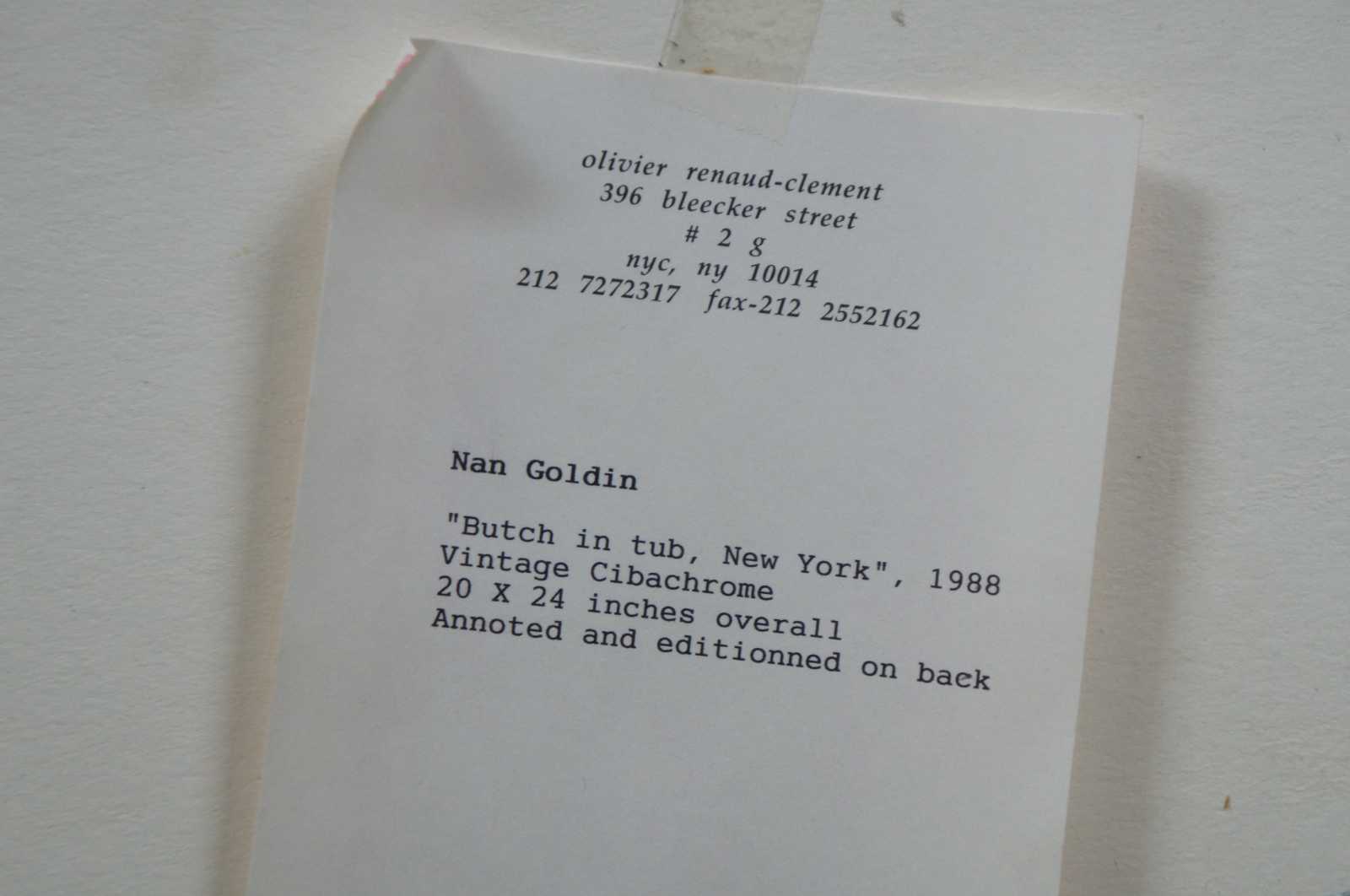
Nan Goldin "Butch in the Tub" 1988 Nude Cibachrome Photographic Signed Print #1
Sold
Shipping:
Free Shipping Included
Delivery:
Estimated 2-15 Business Days
Payments:
Credit Card, Check, Cash, PayPal, Apple Pay, Venmo
Returns:
30 Days 100% Money Back Guarantee, Buyer Pays Return Shipping
Description
Butch in the tub"
by
Nan Goldin
Edition #1 of 25, Cibachrome print
from The Ballad of Sexual Dependency, 1988
Nan Goldin's images of her friends: drag queens, drug addicts, lovers and family -- are portraits that, create a document a generation. Goldin once said that her work ""derives from the snapshot. It is the form of photography that most closely stands for love.""
On September 12, 1953, Goldin was born in Washington, D.C. and soon after, her and her family moved to a suburb of Boston. When Nan was 14 years old, her older sister, Barbara Holly Goldin, committed suicide. Upset by this event, she created an alternate family of friends. She also decided that traditional schooling was not for her, living with a series of foster families, and enrolled in an alternative school called Satya Community School. It was at Satya, located in Lincoln, Massachusetts, that Goldin met two people who would be great friends and influences for many years to come: David Armstrong and Suzanne Fletcher.
There Goldin's fascination with photography truly began to take shape. Over the course of 16 years, Goldin worked on ""The Ballad of Sexual Dependency"" addressing the ""blurry line separating the genders"" and photographed drag queen beauty contests during the early 1970s and became friends with many transvestites. Goldin saw drag as a way to reinvent oneself, and took photographs of friends in full drag dress, as well as in various stages of preparation.
Goldin studied at the Boston School of Fine Arts, and it was here that her photographic style evolved. Before this she had only worked in black and white film, shooting primarily from available light sources. She introduced color and flash which would soon create the ""Goldin look."" Rarely working from natural light, Goldin illuminates her subjects with careful use of flash that extenuates her vibrant colors. She achieves optimum colors and sharp, bright quality by printing her 35 mm film with a photographic process called Cibachrome, in which the prints are photographs printed from slides.
Goldin's 1978 move to the Bowery in New York City marked a major life change, both in her career and her personal life. Reflecting her and her friends' lifestyle, including excessive use of drugs, alcohol and abusive relationships. Goldin wrote, ""I believe one should create from what one knows and speak about one's tribe . . .You can only speak with true understanding and empathy about what you've experienced.""
Holding her beginning show at punk rock clubs in New York City, they combined photographs and music and ran about 45 minutes. Tin Pan Alley was one of the most frequent spots for these events, that also featured up-and-coming artists like Kiki Smith, Cookie Mueller and Barbara Ess. It was in 1986 that Goldin began to take her show on the road, traveling abroad to exhibit her work, at both the Edinburgh and Berlin Film Festivals.
By 1988, Goldin entered a detoxification clinic, when her drug and alcohol abuse began to take a toll on her life and work. It was at the clinic that she created many self-portraits, which she had previously experimented with, but not to this extent.
Goldin was also losing many friends to AIDS, including long time friend Cookie Mueller. Goldin began ""The Cookie Portfolio,"" a series of 15 portraits of Cookie, following their first meeting, youthful parties to Cookie's funeral in 1989. During the next few years, Goldin continued to photograph her slowly dwindling circle of friends. Exhibiting across the country and around the world, she spent a year in Berlin on a DAAD grant, sponsored by a German organization that brings artists to Berlin. In 1994, she and her longtime best friend David Armstrong collaborated on a book called ""A Double Life.""
A 1995 show at the Institute of Contemporary Art in Boston grouped Goldin, Armstrong and fellow photographers and friends Philip-Lorca DiCorcia, Mark Morrisroe, Jack Pierson and several others, and dubbed them the ""Boston School.""
The Whitney Museum of American Art held a retrospective of Goldin's work in 1996; it was called I'll Be Your Mirror.
Condition
Very Good - See pictures
Dimensions
30” x 22” x 1.25” (Width x Height x Depth)











